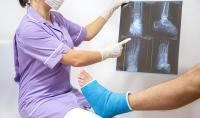How to shorten rehabilitation time after a fracture?
PhD students from the Warsaw University of Technology have figured out how to make recovery from a limb fracture shorter and less strenuous. In their PulseLAYERS project, they decided to use printed electrostimulation layers.
Any immobilisation of a limb is associated with an inevitable loss of muscle mass. After six weeks, this can amount to approximately 20 per cent. Research confirms that electrostimulation can effectively counteract this loss. It also has other advantages. Studies on its application show that it has a positive effect on the healing process itself.
– Our solution reduces the atrophy of the patient's muscles during the fractured limb's re-growth and makes it possible to limit the onerous and difficult rehabilitation process to a minimum – explains team leader Dominik Baraniecki. – It also reduces the risk of complications related to bone fusion and speeds up healing.
PulseLAYERS takes the form of an overlay – a specialised dressing worn over the fracture site. It contains sensors (temperature and pressure) and electrodes responsible for electrostimulation. The developers of the idea use printed electronics - an increasingly popular method of manufacturing electronic components on various substrates. This method requires the development of detailed pastes, but is efficient and has a very wide range of applications.
Behind the PulseLAYERS project is a group of PhD students from the Warsaw University of Technology: Dominik Baraniecki, Filip Budny, Jan Dominiczak, Aleksandra Kądziela, Łukasz Nowicki and Izabela Wojciechowska.
– We plan to raise funds in the form of grants or ongoing research and development projects in order to bring the device to the level of proof of concept and possible implementation – says Dominik Baraniecki.
The young scientists presented their idea during Tech-Athon, a polytechnic marathon of work on innovative solutions with implementation potential. The team received an award and PLN 30 000 for the development of the idea in this competition.








